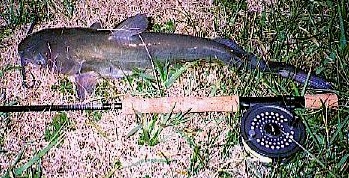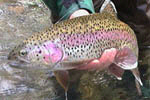|
Fly Tied By:
Adam
Trahan
Originated By: Adam Trahan
Story By: Adam Trahan
Home: Phoenix, Arizona
E-mail:
adam@smallstreams.com
Web site:
www.smallstreams.com |
Adam is a prolific writer,
hard-core outdoor enthusiast, and avid small-stream angler.
Keeping things simple is paramount to Adam's fishing
enjoyment. If you ever see him on his favorite small stream,
you will find him wearing an eclectic collection of
clothing, carrying a light-line fly rod and sporting only a
small fly box, a spool of tippet, and a nipper around his
neck.
|
The Introduction
Catfish can be caught with
fine wine and dog food if one is persistent. Take a wine
cork (may I suggest a Chardonnay?), a fly rod, and a farm
pond with some catfish that are fed regularly and you are
into this new and exciting form of fly-fishing. Farm ponds
in the East usually hold channel catfish. The owner will
stock the pond with catfish fingerlings (kitten fish?). More
than likely he will feed the fish dog food or food designed
for fish in ponds. It comes in the form of small pellets and
it floats on the surface. The owner will throw out this food
and usually a feeding frenzy will follow. You want to be
there during feeding time. The size and number of fish is
astounding...
The "Pattern":
 Try to obtain some of the dog food or pellet food mentioned above.
Take the wine cork, and whittle a piece of it down to the size of
the pellet. Cut a groove for the back of the hook. Now take a wet
fly hook and super-glue the pellet imitation to the hook. Make a few
of these and let dry overnight.
Try to obtain some of the dog food or pellet food mentioned above.
Take the wine cork, and whittle a piece of it down to the size of
the pellet. Cut a groove for the back of the hook. Now take a wet
fly hook and super-glue the pellet imitation to the hook. Make a few
of these and let dry overnight.
The Equipment:
Use a large fly rod line-weight, I use a six-weight. Floating line,
and a 3-4x leader. Tie the "fly" to the tippet section. Don't forget
your hook-removing pliers.
The Technique:
|
 |
Catfish photo courtesy of Adam Trahan.
First get
permission from the owner of the pond, and ask him when he
feeds his fish. If you tell him that you are a "catch and
release" fisherman, he will probably want you to keep the
fish for him. Position yourself within casting distance from
where he will throw the food. When the feeding frenzy
begins, cast your offering to a small group of pellets. Your
pellet will ride slightly higher in the water than the
others and about half the time you will be able to see the
take. If you can't see your pellet, just watch your line.
You will catch lots of catfish in the first few minutes.
Most will be small at this time. Do not get discouraged if
you don't catch a big one. The larger fish will wait till
the food gets blown or drifted to the edge of the water.
Then they will go about scooping large amounts of pellets
from the edge of the pond. This is where it pays to be
patient. Cast to a large group of pellets and try to keep
the leader hidden off the water onto the bank. More often
than not, you will be rewarded with a large catfish fight.
Reflections:
I have seen several
selective feeding catfish avoid my pellet in a pile of fish food. I
believe it was the lack of "smell". Take some pellets, crush them
up, and add a little water to make a paste. Coat your pellet with
this paste and let it dry. This will last only a couple of minutes
in the water, so change pellets often if you are having trouble with
educated catfish. Also, try the more expensive wine corks. They are
of extra flora grade cork, and are a bit easier to shape. Feel free
to e-mail me with any comments or questions.
--
Adam Trahan
|
|
|

Photo by Peter Frailey
|
Hook: |
Wet fly hook, size 18 |
|
Body: |
Wine cork, whittled to size and shape of food
pellet (about 1/4" diameter) and super-glued onto hook. |
|
|
|
copyright © Notice by fishingwithflies.com.
All rights reserved. This
material is for your personal enjoyment. Please obtain prior
written permission from the author and fishingwithflies.com
before any other
use. |



